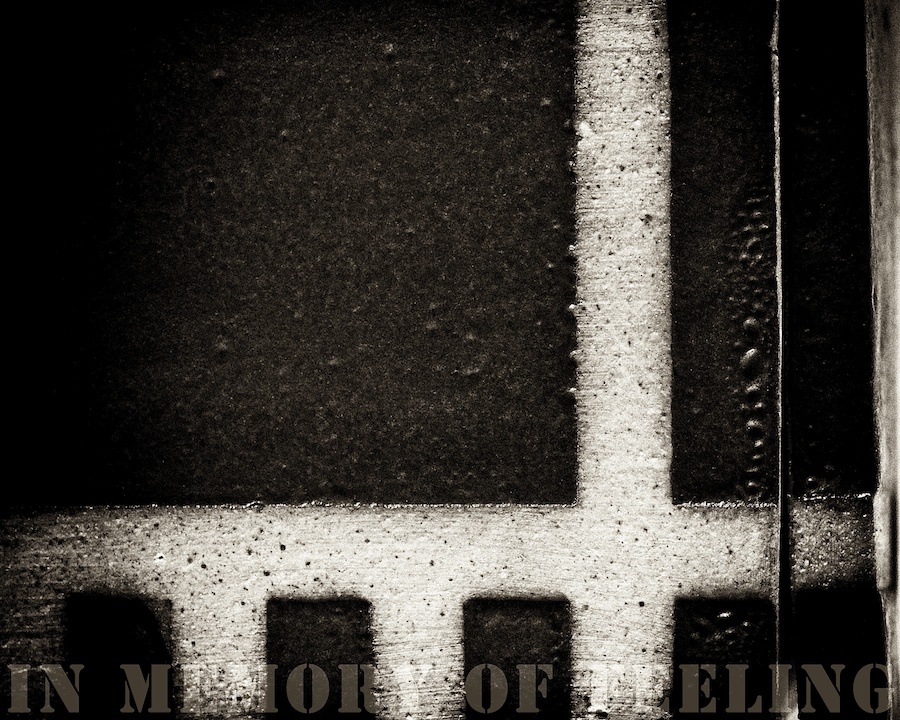


In the previous two posts I have discussed the use of titles with images (and pieces of music); for the next posts I want to move on to a related issue, namely the use of words (text) within the image frame itself. But first some context: for this project I intend to explore relationships between images and music, specifically referencing the music of my friend and co-contributor here, Marc Yeats. Referencing but in no way “illustrating” (for me a mostly meaningless exercise) of course. The intention is that this should be an exploration of how expression and/or meaning is formed and conveyed in both media and where the process and methods available may (or may not) crossover, as it were. With such an enterprise there naturally remains the possibility that what I am seeking is largely unattainable in any sense beyond surface affects (and effects, too, of course). This, for me, is what makes the project worthwhile but thus entails a great deal of research, thought and preparation before I embark on the actual construction of my visual pieces. Part of this entails, also, my looking back on previous work of mine in the context of method, use of motifs etc. – basically, what has worked before and what hasn’t, I guess.
At this point I’m reminded of the oft used phrase “A picture is worth a thousand words”; a meaningless phrase if ever there was one, for a start the question “But which thousand words?” would seem apropos here. I should note here the often necessary, one could say almost obligatory, use of titles in documentary image making. Though here they are usually referred to as “captions”. Images can provide a great deal of information but they can rarely supply context. Going back to titles for visual pieces where the intent is artistic, there is arguably less need for the informative or descriptive title (though many are just that) but pure information is not usually the main purpose, that being the far less clear cut issue of expressing, conveying, meaning. And meaning and information are not the same thing. The same applies to the use of words within an image – and where this can be said to be fairly straightforward one is usually not referring to words as information, as such, but for descriptive purposes in order to express, or reinforce, meaning. Even within the confines of the image itself words can express that which can only be represented in a written text… a “scription”, a (de)scription that is. But by “description” here I mean in the rhetorical sense; referring back to the root of the word “describe” – describere, to “write down”. And this in order to compensate for the shortcomings of images themselves which, while better than words for showing structural relations, cannot easily express “abstract concepts” in the way that words can. And not just words either (and here we touch on my main reason for exploring these issues), music can express little other than abstract concepts.
In my own past practice I have made little use of text within images (as I have not used titles for individual pieces either) and where I have it has been for “descriptive” purposes, but description with a heavy dose of irony, usually to state the blindingly obvious. One project where I did make an allusive use of text, however, was “Stufen Der Scheinbarkeit” (taken from a phrase used by Nietzsche in Beyond Good and Evil, roughly translated: “degrees of seemingness”). How this came about was quite convoluted: I had been toying with concepts of “Metanoia” in relation to a mention of it I had read in the catalogue for a Jasper Johns show from some years ago of the monochrome pieces in his oeuvre, titled, not surprisingly, “Gray”. The word itself is of elusive meaning as, though its original meaning is “repentance”, in a theological sense, it can also mean a “correction”, as a rhetorical device and, in psychology, means “the process of experiencing a psychotic break down and subsequent, positive psychological re-building or healing”. All of these meanings were possible in relation to Johns; an artist whose work is full of personal associations of which few are clear due to his reticence in discussing such matters and for this reason an artist I have always personally identified with. Johns is not a man to wear his heart on his sleeve, either artistically or in private life. A master of the obscure allusion if you like.
At the same time as this, a line from Leonard Cohen’s Hallelujah (a favourite song of mine) had been going around in my head: “I couldn’t feel, so I learned to touch”. A line with the sort of duality of meaning that appeals to me; “feel” and “touch” having a dual meaning, one physical and the other emotional. Also at this time I had made some images, mostly textural close ups, of some of the earthenware pieces in my wife’s collection. The textural nature of these images, indeed, were highly evocative of the sense of touch but “touching” too, for me, as personal to my wife. I guess all these connections and associations came together in my decision to use the phrases I constructed within the images which all allude to this duality of meaning. Maybe in a personal way, but maybe not, too. It is not intended that the viewer necessarily glean some personal angst from these juxtapositions. On the other hand, subconsciously? Who knows? I guess that’s the point…
The allusions, however, don’t end there. In the image taken from the series and shown above, the text “In Memory Of Feeling” is an allusion to another piece of mine from my “Figuring Jasper” series which itself was lifted virtually intact from a piece by Johns (both are shown above) titled “In Memory Of My Feelings”. In the case of my near use of the same phrase, I merely “depersonalised” it. Yet, it can by no means be certain that in the Johns piece he is referring to his own “feelings” as the title is a line lifted from a poem by Frank O’Hara. Meaning in art can be both allusive and elusive and though sometimes there is more than meets the eye, equally there may well be less.
In relation to my current project I am minded to make far greater use of words and text within the visual pieces themselves; indeed it may be the only solution to some of the problems of constructing a “bridge” as it were between image and music. Interestingly, I know for a fact that Marc himself has an (unnatural? natural?) aversion to the use of text within visual art. We shall have to see… In the meantime, in the next post or two, I want to move away from the use of words as meaning and towards their use as visual elements in their own right in a form of “regression” back to the original status of words as marks at the point they broke from drawing (scribbles?) and acquired meaning both (pre?)historically and in relation to child development. To divorce words, too, from meaning and refer back to them as pure sound, as poetic elements in their own right. Just like the function of notes in music?
The post (De)scription and degrees of seemingness appeared first on VISCER-ebr-AL.
Aucun commentaire:
Enregistrer un commentaire